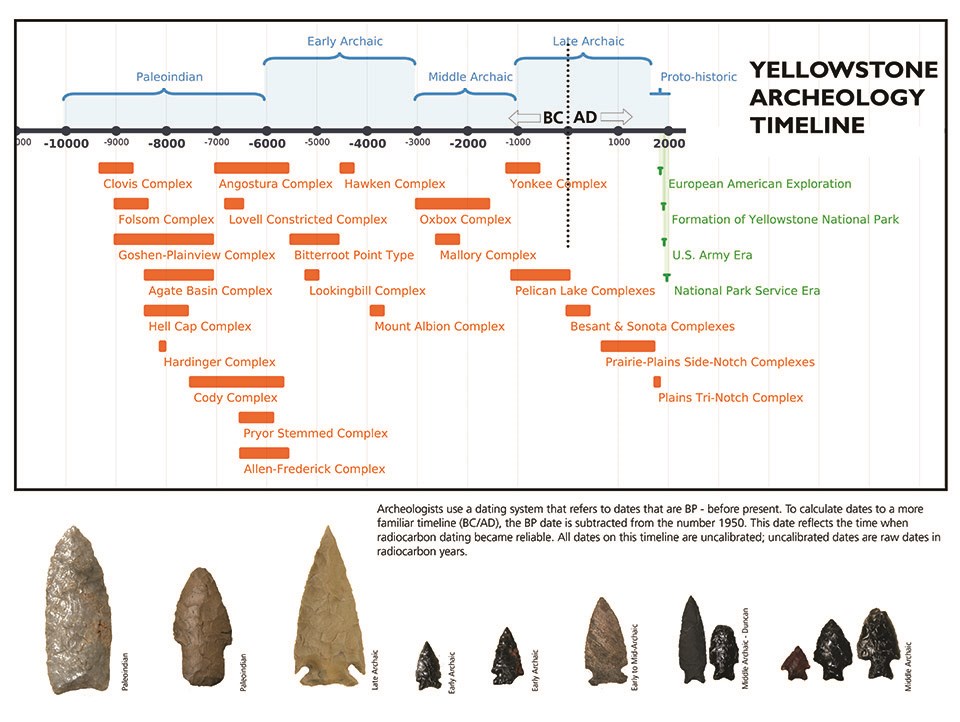A new issue of Yellowstone Science magazine takes an in-depth look at archaeology in Yellowstone, celebrating the achievements of recent research and tracing the history of the park’s archaeology program. From historical Native American use through modern times, the park’s 2.2 million acres is a treasure trove of historical and cultural artifacts. The information below represents an impressive snapshot of the wealth of archaeological sites, artifacts and data that the park has researched, cataloged, and preserved. We encourage you to read the digital version of the magazine for a deeper dive into unearthing and understanding Yellowstone’s past.
- The Heritage & Research Center in Gardiner holds 1,121,997 cultural and natural history objects, as of October 2018. The archaeology collection accounts for 611,088 of the total.
- There are 954 buildings, historic roads, historic bridges, and constructed features in YNP.
- 1,935 archaeological sites have been identified in the park, as of November 2017.
- Only about 3% of the park has been surveyed for archaeological sites.
- If site density over the whole park is similar to the currently surveyed portion, the park potentially contains 60,000 archaeological sites. It’s unlikely that the actual number is this high, as much of the park is on steep slopes; but the current density still shows that Yellowstone is a very archaeologically rich area.
- Yellowstone contains six National Historic Landmarks: the Northeast Entrance Station; Fort Yellowstone (which includes the Roosevelt Arch); Lake Hotel; Old Faithful Inn; the Norris, Madison, and Fishing Bridge museums (joint NHL group containing all three); and Obsidian Cliff.
- Obsidian Cliff is one of the few archaeological National Historic Landmarks. For at least 11,000 years, people have been extracting incredibly high quality toolstone from the cliff. Ancient tools sourced to Obsidian Cliff outcrops have been found as far away as Maine.

- In addition to the National Historic Landmarks, the Grand Loop Road Historic District (HD), Lake Fish Hatchery HD, Mammoth Hot Springs HD, North Entrance Road HD, Lamar Buffalo Ranch HD, Obsidian Cliff Kiosk, Old Faithful HD, Queens Laundry Bath House, Roosevelt Lodge HD, and Mammoth Post Office are currently listed on the National Register.
- A lithic scatter is a collection of stone debris usually seen on the ground surface here in Yellowstone. Occasionally there may be other artifacts present, such as bone, hearths, or fire cracked rock. These are the most common types of prehistoric sites in the park and can be difficult to accurately date. They are usually the result of people spending a short-amount of time in an area doing things such as sharpening tools, butchering an animal, or staying in an overnight camp.
- Tipi rings are circles of stones that were used to hold the walls of tipis to the ground. They are found throughout the Great Plains and into the Rocky Mountains.
- Wikiups are timber-cribbed dwellings that are usually conical. Resembling a tipi but made of wood, these are semi-permanent homes that would protect the inhabitants from the elements in Yellowstone’s harsh environment. Though 13 wikiups sites have been reported throughout the park since its formation, most or all of the wikiups in Yellowstone have collapsed over the years.
- Game drives are rows of stone cairns or wooden fences that were used in hunting. The structures were used to funnel game herds into areas selected by hunters for more efficient kills.
- Rock art sites are located throughout the area surrounding Yellowstone, but have not been identified in the park. In surrounding areas, both pictographs and petroglyphs have been found.
- Quarries are sites where Native Americans extracted stone for use in tools. The various obsidian quarries in the park have attracted the most attention from archaeologists, but quarries for other materials such as chert are also found within the park.
- Stratigraphy is one tool that archaeologists have to determine relative ages of different artifacts. Typically, as artifacts fall to the ground, older deposits are lower in the soil column and newer ones are closer to the surface. We call this relative dating. We can tell which artifacts are older and which are newer without having an exact age.
- Absolute dating is more precise than relative dating. There are a wide variety of absolute dating techniques, but the most commonly used in Yellowstone is radiocarbon dating.
- High elevation sites around ice patches are usually the remnants of hunting expeditions following game into cooler elevations during summer.
- Radiocarbon dates measure the different ratios of radioactive Carbon 14 and stable Carbons 12 and 13 in an organic substance. Ordinarily charcoal is used for radiocarbon dates; however, many things, including bones, teeth, and wood or plant materials, can be radiocarbon dated. After an organism dies, including a plant which may have been burned into charcoal, the 14C begins the process of radioactive decay. By measuring the 14C/12C ratio in an organic object we can get a fairly accurate date of death. The oldest current radiocarbon date from an archaeology site in Yellowstone comes from a site near Gardiner, dating from 9,690 ±50 years before present.
- President Theodore Roosevelt signed the Antiquities Act into law on June 8, 1906, thus establishing the first general legal protection of cultural and natural resources in the United States. This, and other laws, prohibits the collection of any archaeological materials on public lands, including Yellowstone National Park.

Comments are closed.